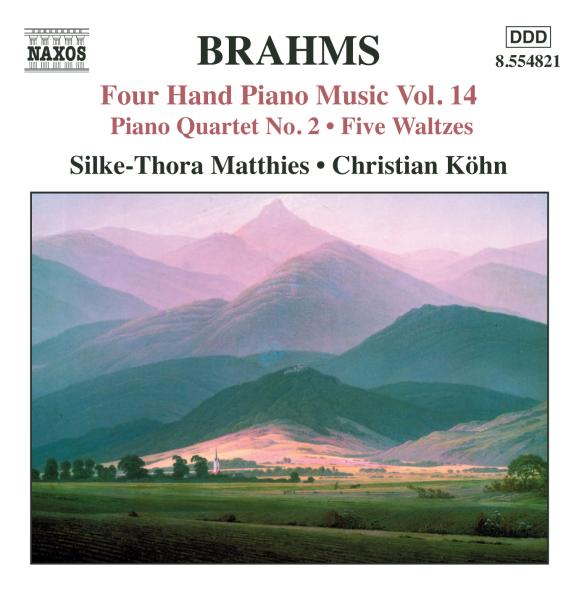Votre cherche:
pas de sélection
Résultats limité:
|
plus d'articles de Silke-Thora Matthies / Chr. Köhn |
| Remarque / Liste des chansons: |
 01. Matthies, Silke-Thora "Piano Quartet No. 2 in A major, Op. 26 (version for piano 4 hands): I. Allegro non troppo" 01. Matthies, Silke-Thora "Piano Quartet No. 2 in A major, Op. 26 (version for piano 4 hands): I. Allegro non troppo" 02. Matthies, Silke-Thora "Piano Quartet No. 2 in A major, Op. 26 (version for piano 4 hands): II. Poco adagio" 02. Matthies, Silke-Thora "Piano Quartet No. 2 in A major, Op. 26 (version for piano 4 hands): II. Poco adagio" 03. Matthies, Silke-Thora "Piano Quartet No. 2 in A major, Op. 26 (version for piano 4 hands): III. Scherzo (Poco Allegro)" 03. Matthies, Silke-Thora "Piano Quartet No. 2 in A major, Op. 26 (version for piano 4 hands): III. Scherzo (Poco Allegro)" 04. Matthies, Silke-Thora "Piano Quartet No. 2 in A major, Op. 26 (version for piano 4 hands): IV. Finale (Allegro)" 04. Matthies, Silke-Thora "Piano Quartet No. 2 in A major, Op. 26 (version for piano 4 hands): IV. Finale (Allegro)" 05. Christian Kohn "5 Waltzes, Op. 39 (version for 4 hands): No. 1 in B major" 05. Christian Kohn "5 Waltzes, Op. 39 (version for 4 hands): No. 1 in B major" 06. Christian Kohn "5 Waltzes, Op. 39 (version for 4 hands): No. 2 in E major" 06. Christian Kohn "5 Waltzes, Op. 39 (version for 4 hands): No. 2 in E major" 07. Christian Kohn "5 Waltzes, Op. 39 (version for 4 hands): No. 3 (No. 11) in B minor" 07. Christian Kohn "5 Waltzes, Op. 39 (version for 4 hands): No. 3 (No. 11) in B minor" 08. Christian Kohn "5 Waltzes, Op. 39 (version for 4 hands): No. 4 (No. 14) in G sharp minor" 08. Christian Kohn "5 Waltzes, Op. 39 (version for 4 hands): No. 4 (No. 14) in G sharp minor" 09. Christian Kohn "5 Waltzes, Op. 39 (version for 4 hands): No. 5 (No. 15) in A flat major" 09. Christian Kohn "5 Waltzes, Op. 39 (version for 4 hands): No. 5 (No. 15) in A flat major"
|
 | | Nombre de disques: |
1 |
 | | Description: | The Piano Quartet No. 2 in A major, Op. 26, written during the same period, had it's first performance in Vienna on 29th November 1862 by the same performers, in a concert in which Brahms played his Handel Variations and keyboard works by Bach and by Schumann. The concert followed shortly after Brahms had received the disappointing news of the appointment of Julius Stockhausen as conductor of the Hamburg Philharmonic, a position for which he had hoped. In a letter home from Vienna, however, he was able to report the sympathetic reception of his new piano quartet and his success with the audience as a pianist. Hanslick, who had followed Brahms's career with close interest, still had reservations, but Clara Schumann preferred the quartet to it's immediate predecessor. In 1870 the publisher Simrock asked Brahms for a four-hand piano arrangement of both quartets. He agreed to supply these, asking that his name as arranger should be included. Simrock did not agree to this last request, and printed the four-hand piano version of the Quartet in G minor without this acknowledgement and with many mistakes, as the proofs had not been sent to the composer for correction. This led Brahms to delay the arrangement of the second quartet until 1872. He had at first asked for a fee of fifteen Friedrichsdor, having received only twelve for each original composition, but was not pleased to receive in 1872 only the earlier agreed fee. His complaint persuaded Simrock to send a further fifteen Friedrichsdor. The work, which is admirably suited to piano duet, is of some length, and makes wide use of sonata form. The opening subject has two elements, a chordal theme and a winding thematic element first heard from the cello. The second subject that follows is replete with the composer's habitual cross-rhythms. The central development unusually includes three variations of the first theme, before it's return in recapitulation. The slow movement, Poco Adagio, and originally scored at first with muted strings, offers a lyrical principal theme, the strings unmuted on it's return, after the contrasting secondary material. The extended Scherzo, unusually in sonata form, has a D minor Trio that uses thematic material from the Scherzo in it's canonic writing. The quartet ends with another sonata-form movement, it's rhythmic first subject with touches of the Hungarian. It makes a splendid and complementary ending to a work that wears the unmistakable stamp of Brahms throughout. Brahms completed his sixteen Waltzes, Op. 39, in 1865, publishing them in a piano duet version in 1866 and a version for solo piano the following year. He dedicated the work to Eduard Hanslick, the genre and dedication both, perhaps, a tribute to Vienna, where he had been welcomed. In 1897 the publisher Rieter- Biedermann issued a two-piano version of five of the waltzes, included in the present recording., Runningtime: 00:00:00, Composed By, Arranged By: Johannes Brahms, Cover [picture]: Caspar David Friedrich, Liner Notes: Keith Anderson (6), Piano: Christian Köhn, Piano: Silke-Thora Matthies, Producer: Tonstudio van Geest, Labelcode NXS8554821.2 (8.554821), Phonographic Copyright (p) Naxos Rights International Ltd., Copyright (c) Naxos Rights International Ltd., Recorded At Clara Wieck Auditorium, Heidelberg |  | | N° de titres: |
9 |
 | | N° de fabricant: |
8554821 |
 | Sécurité des produits
Personne responsable pour l'UE:
NAXOS RIGHTS (EUROPE) LTD
41-51 Brighton Road, Surrey RH1 6YS Redhill, UK
info@naxos.com |  |
|
Les clients qui ont acheté ce produit ont aussi acheté
Il n'y a pour le moment aucune critique sur ce produit.
|  |
|
|
 |
|






























